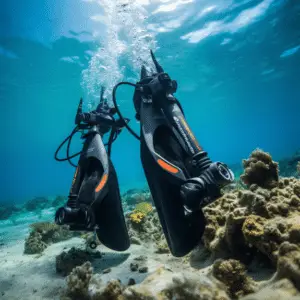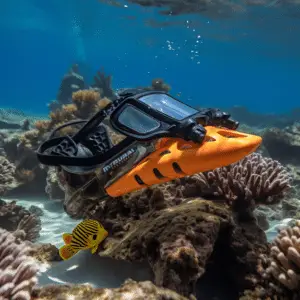
Scuba fins for diverse diving conditions unlocks the wonders of the underwater world. But, first, you need the right equipment! Fins are key to diving performance. They can make or break a dive based on the conditions.
For example, when facing strong currents, split fins work best. They reduce drag and require less effort to kick. When exploring coral reefs or wrecks, paddle-shaped or stiff-bladed fins are best. They offer more power and allow for subtle adjustments.
Skill level and personal preference also matter when selecting fins. Novices may prefer shorter blade fins for better control. Experienced divers may opt for longer blades to cover more distance. Regardless of fins, proper technique is essential. Master techniques like flutter kicks or frog kicks to maximize efficiency and conserve energy.
Divein.com reports that using the right fins for specific conditions leads to comfort and safety. Understanding different fin designs and their suitability for various scenarios can enhance your diving experience.
Understanding Different Diving Conditions
Fins are vital in diving. They provide control, maneuverability, and speed underwater. Let’s look at which fins are best for different diving conditions.
Warm Water: Full-foot Fins
Cold Water: Open-heel Fins
Strong Currents: Split Fins
Shallow Waters: Short Blade
Deep Waters: Long Blade
These are guidelines, not rules. Full-foot fins are comfy and flexible for warm water dives. Open-heel fins work better with thicker booties in cold water. Split fins are great for strong currents. They reduce resistance and boost maneuverability. Short blade fins are better for shallow water as they give you more control. Long blades are better for deep water as they give more propulsion.
It’s amazing to see how different fins have been made for different conditions. Divers are always adapting and pushing boundaries. Knowing this helps us understand how humans explore the depths of the ocean.
Types of Fins for Different Diving Conditions
Fins are essential for divers. Choosing the right type can make a real difference in diving performance. Different conditions need different types of fins for optimal propulsion and maneuverability. Let’s explore the various fins suitable for different conditions and how they work.
Open heel fins have adjustable straps for a secure fit. They are great in cold water or strong currents and you can wear booties or thick neoprene socks underneath. Full foot fins have a closed-toe design for comfort. They are good for warm water and calm conditions.
Split fins have a split blade design for efficient kicking. They are suitable for all-around diving conditions and are good for divers of all levels. Jet fins have rigid blades for more power. They are perfect for technical diving and deep water exploration.
It is important to choose the right fin type. Consider factors like water temperature, current strength and maneuverability needed. Each fin type has unique features and design, allowing divers to optimize their performance.
Factors to Consider When Choosing Fins
When picking fins for diving, there are some important points to keep in mind. These factors are key for comfort, efficiency, and safety. Here is a breakdown of what to consider:
- Flexibility: Fins’ flexibility affects performance in different diving situations. Stiffer fins provide power and control for strong currents and technical dives. Flexible fins are great for leisurely dives or snorkeling.
- Blade Length: This affects propulsion efficiency. Longer blades generate more thrust for deep dives or challenging currents. Shorter blades are good for improvised diving or travel.
- Material: This defines fins’ durability and resistance to wear and tear. High-quality materials like fiberglass or carbon fiber enhance performance and last longer. Plastic is more budget-friendly but may not be as strong.
- Foot Pocket Design: A good fit is crucial for comfort and avoiding blisters. Different designs fit different foot shapes. Try some on before buying.
- Strap System: This secures the fins and should be adjustable. Look for quick-release buckles or spring straps for convenience when putting on or taking off.
- Weight: Lighter fins mean less leg fatigue but lack stability against strong currents. Heavier fins provide stability but may be tiring after extended use.
Assess these factors to get fins that suit your style and let the wonders of the underwater captivate you. Don’t miss out on what lies beneath!
Conclusion
Long-bladed fins are perfect for diving in tranquil, clear waters. They provide great thrust and agility, allowing divers to sail effortlessly. Additionally, their length helps them save energy.
If you’re set to dive in wild, choppy seas, shorter fins are optimal. They provide control and steadiness, helping avoid exhaustion and keeping the diver safe.
Split fins are a must for those who do technical dives or explore caves. Their unique design lets them direct water flow during up and down strokes, improving maneuverability and reducing effort.
Adjustable strap fins are ideal if you share equipment. They can be adjusted to fit different foot sizes perfectly, making sure divers are both comfortable and effective underwater.
It’s essential to take into account variables such as water transparency, current strength, and dive type when selecting fins. This will guarantee a fun and successful experience each time!
Frequently Asked Questions
Q: What types of fins are suitable for calm diving conditions?
A: For calm diving conditions, open-heel paddle fins or full-foot split fins are recommended. These fins provide good maneuverability and require less effort to kick.
Q: What types of fins are suitable for strong currents?
A: In strong currents, it is best to use closed-heel adjustable fins or spring strap fins. These fins offer better control and power, allowing divers to swim against the current with less effort.
Q: Can I use Scuba fins for diverse diving conditions?
A: Yes, short fins or travel fins are suitable for diving in areas with limited space or for travelers who want to minimize luggage size. However, they may not provide as much power as longer fins.
Q: Are Scuba fins for diverse diving conditions
A: While split fins are generally versatile and suitable for various diving conditions, they may not be ideal in strong currents where maximum power and control are required.
Q: What are the benefits of using full-foot fins?
A: Full-foot fins are lightweight and compact, making them great for warm-water diving and snorkeling. They also provide a snug fit and better energy transfer, resulting in more efficient kicks.
Q: Can I use Scuba fins for diverse diving conditions?
A: Yes, scuba diving fins can be used for snorkeling. However, they are designed for longer and deeper dives, so they may feel slightly bulky and require more effort for surface swimming compared to snorkeling-specific fins.

